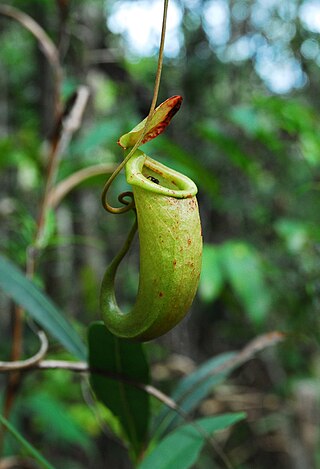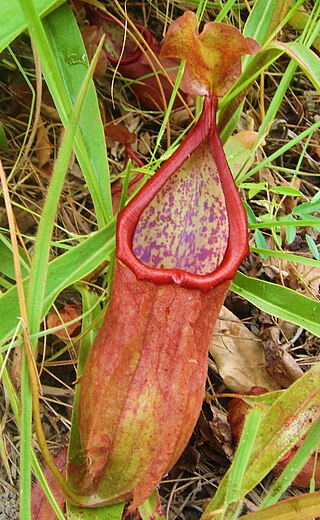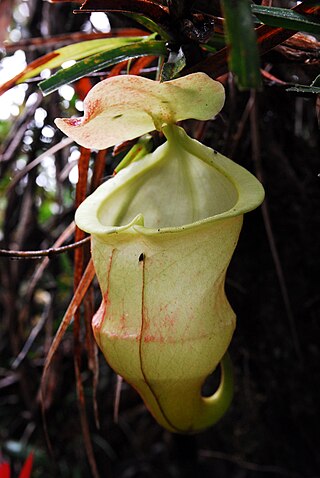
Kapangan, officially the Municipality of Kapangan,, is a municipality in the province of Benguet, Philippines. According to the 2020 census, it has a population of 19,297 people.

Nepenthes sibuyanensis is a tropical pitcher plant endemic to Sibuyan Island in the Philippines, after which it is named.

Nepenthes bellii is a tropical pitcher plant endemic to the Philippine islands of Mindanao and Dinagat, where it grows at elevations of 0–800 m above sea level.
Martin Roy Cheek is a botanist and taxonomist at the Royal Botanic Gardens, Kew.
Samuel M. Dangwa was a Filipino politician.

Nepenthes micramphora is a tropical pitcher plant known only from Mount Hamiguitan on the island of Mindanao in the Philippines. It is a highland plant growing at elevations of 1100–1635 m.

Nepenthes andamana is a tropical pitcher plant endemic to Phang Nga Province, Thailand, where it grows near sea level in coastal savannah and grassland. It is thought to be most closely related to N. suratensis.

Nepenthes suratensis is a tropical pitcher plant endemic to Surat Thani Province, Thailand, where it grows near sea level in coastal savannah and grassland. It is thought to be most closely related to N. andamana.

Nepenthes hamiguitanensis is a tropical pitcher plant endemic to a single peak on the Philippine island of Mindanao, where it grows at elevations of 1200–1600 m above sea level. Once thought to be a natural hybrid between N. micramphora and N. peltata, this plant is now considered a species of possible hybridogenic origin. It produces squat upper pitchers that vary greatly in pigmentation, from red speckled to yellow throughout.

Lilium philippinense, commonly known as the Benguet lily, or Philippine lily, is a lily native to Taiwan and to the Cordillera region, primarily to the province of Benguet, in the northern Philippines. This flower has several native names like us-usdong, kanyon and sabong ti bantay.
Julie F. Barcelona is a Filipina botanist and taxonomist working as Research Associate at University of Canterbury. She is mostly known for her research on the Philippine members of the genus Rafflesia.

Begonia palmata is a species of plant in the genus Begonia of the family Begoniaceae. It is a small herb of height 20–90 cm tall. It is found in moist places, next to streams or under the shade. It is found in many parts of Asia, including eastern Himalayas.
Begonia quinquealata is an endemic species of Begonia discovered in Salakot Falls, Napsan, Puerto Princesa City, in northern Palawan, Philippines. This species, along with B. suborbiculata Merr., are the only two known species in the Philippines with 5-winged capsules. Unlike any other member of Begonia sect. Baryandra, B. quinquealata is very distinctive for being a densely hairy herb with long creeping rhizomes. It differs also from B. suborbiculata in that it has thickly chartaceous, widely ovate leaves that have uniformly green upper leaf surface, densely velutinous, with denticulate leaf margin, outer tepals, and red scabrous ovary and capsules.
Begonia tenuibracteata is an endemic species of Begonia discovered in Salakot Falls, Napsan, Puerto Princesa City, in northern Palawan, Philippines occurring on mossy boulders along road cut in shaded, wet lowland forest. This species, along with B. mindorensis, produces the unusual, conspicuous, persistent bracts on the inflorescences. However, it sharply distinct from the latter due to its ovate to lanceolate bracts, which are hyaline, membranaceous, glabrous or with very sparse sessile glands where the latter have widely to depressed ovate bracts that are coriaceous, densely clothed with sessile glands. Additionally, B. tenuibracteata differs by the congested rhizomes with internodes only to 3 mm long; with shorter petioles ; velvety upper leaf surface; shorter inflorescence ; and fewer stamens (40–50); whereas B. mindorensis have 20 mm long rhizome internodes, petioles 10–25 cm long, glossy upper leaf surface, inflorescence over 35 cm long, and up to ca. 70 stamens
Begonia adamsensis is an endemic species of Begonia discovered in Adams, Ilocos Norte province, Luzon, Philippines occurring at an altitude of 308 m above sea level. The species broad-based leaves that are peltate, with a glabrous peduncle, an acuminate tip and nearly entire margin, resembled that of Begonia hernandioides. However, there are differences, in that B. hernandioides had red-colored stipule that is broadly ovate, the petiole and abaxial lamina is pubescent, and the peltate leaves are elliptic.
Discospermum philippinensis is a species of flowering plant in the family Rubiaceae. The species was described in 2015, and was found on Mt. Banahaw, Tayabas, Quezon Province, Philippines at an elevation of 623 m. This species closely resemble that of D. whitfordii because of its persistent calyx, and prominent disk below the fruit apex. However, the species differs from D. whitfordii due to leaf blades with a much larger dimensions, the leaf apex of which are acute to attenuate, the fruits of which are faintly ribbed, with the thin mesocarp that are smaller, and fewer seeds per locule.

The Upper Agno River Basin Resource Reserve is a protected area located on the southeast flank of the Cordillera Central in the Philippine province of Benguet along its border with Ifugao and Nueva Vizcaya. It is a resource reserve located high in the Central and Polis ranges protecting the headwaters of the Agno River. According to section 4 of the National Integrated Protected Areas System Act, a resource reserve is an extensive and relatively isolated area designated as such to preserve the natural resources of the area. The reserve comprises 77,561 hectares of the catchment area that feeds the Ambuklao and Binga dams, two of the country's oldest hydroelectric plants that supply power to the city of Baguio and entire Benguet province. Upper Agno is north of and contiguous with the Lower Agno Watershed Forest Reserve that preserves the immediate downstream of the Binga Dam where the Agno River is impounded by a third dam, the San Roque Dam, the largest in the Philippines and the main source of water, electric energy and irrigation for surrounding regions in Luzon.
Begonia cabanillasii is a species of flowering plant in the family Begoniaceae, native to the island of Palawan in the Philippines.
The Philippine Taxonomic Initiative (PTI) is a private Philippine research institute and non-profit organization founded in 2018, located in the Philippines.

Begonia noraaunorae is an endemic species of Begonia found in Surigao del Sur, Mindanao Island, Philippines. The species was compared to B. negrosensis Elmer, from which it resembled by its glabrous stems, leaves that are obovately oblong in shape and with sparse hairs, the lamina with glossy surface adaxially and light green abaxially, the staminate flowers having 2 tepals, the pistillate flowers having 5 tepals, and the green ovaries. However, this species differed from B. negrosensis by its larger leaves with scattered light green patches, shorter stems, a much larger, serrated lamina, shape of tepals of staminate flower, and longer ovary with no subtending bracteoles. The species is named after the Filipina actress and National Artist, Nora Aunor. The species is classified under IUCN Red List criteria as Vulnerable.










